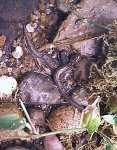Kansamander
Member
- Joined
- Sep 28, 2018
- Messages
- 43
- Reaction score
- 32
- Points
- 18
- Location
- Kansas, USA
- Country
- United States
We have a couple of small ponds which the past couple of years have been full of smallmouth salamander larvae. I got a kick out of raising a few of them, but I get the feeling that larvae mortality is fairly high (literature suggests for the spotted salamander, larval mortality is less than 13%, and I'm guessing similar stats for smallmouths).
So, my thought (half-baked) is to collect a large amount of larvae (or eggs -> larvae), raise and allow to undergo metamorphosis (or on a subset, try to sustain neoteny), and ultimate release 15% or so of the salamanders at the end of summer to mimic the rough % survival in wild.
With the remainder (which would otherwise be bug/amphibian/bird/turtle food) my thought is to establish a decent habitat in our cellar to try captive breeding (fool's errand, but why not?), and potentially even sell some as pets. I know they're uncommon, and very secretive, but I actually liked them as a small and easy to manage salamander. I grew rather attached to the ones last year, but ultimately released them in the wooded area surrounding their breeding pond.
So a few questions - would people have any interest in a salamander like the smallmouth (secretive, comes out at night, really docile), and can anyone(s) comment on the plan from a philosophical/ethical perspective. You won't offend me - I want input before doing anything too crazy.
Thanks in advance!
So, my thought (half-baked) is to collect a large amount of larvae (or eggs -> larvae), raise and allow to undergo metamorphosis (or on a subset, try to sustain neoteny), and ultimate release 15% or so of the salamanders at the end of summer to mimic the rough % survival in wild.
With the remainder (which would otherwise be bug/amphibian/bird/turtle food) my thought is to establish a decent habitat in our cellar to try captive breeding (fool's errand, but why not?), and potentially even sell some as pets. I know they're uncommon, and very secretive, but I actually liked them as a small and easy to manage salamander. I grew rather attached to the ones last year, but ultimately released them in the wooded area surrounding their breeding pond.
So a few questions - would people have any interest in a salamander like the smallmouth (secretive, comes out at night, really docile), and can anyone(s) comment on the plan from a philosophical/ethical perspective. You won't offend me - I want input before doing anything too crazy.
Thanks in advance!

